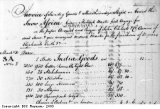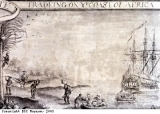A ship’s cargo for Africa
“You have a Cargo on board on our Account amounting to £4,648 [about £370,000 today] which you are to Barter for good healthy young Negroes & Ivory, and we desire you’ll be very careful in that Purchase of the Negroes not to buy any Old Slaves or Children, but Good Healthy Young Men and Women, and buy all the Ivory you can get”. These words were part of the written orders given to George Merrick, master or captain of the ship the Africa for her first slaving voyage in 1774.
The accounts book of the ship the Africa gives a good insight into a slaving voyage. The crew, their jobs, and their wages are listed, along with all the ‘outset’ costs of fitting up the voyage (repairs to the ship, port charges, customs fees, food and stores for the voyage, petty cash).
The ship’s cargo is listed item by item and the value of everything is given. On the first voyage, the ship carried a large stock of cotton cloth from India and Manchester, brass pots, hats and waistcoats, brandy and rum, iron bars and pots, guns, gunflints and gunpowder, copper rods and manillas (both types of currency), glass beads, lead bars and lead shot (for the guns). All these items would be used to exchange with the African traders in West Africa where the ship was headed. These traders would then sell them on.
Pictured here is a page from the accounts book of the ship the Africa. It lists the cloth taken to Africa on the 1774 voyage. Cloth was an important part of any trade cargo as it was so valued by the African traders. It usually made up about a third of the whole cargo. This first voyage was not a great success for her eight owners, as they made very little profit.
On her second voyage, the trade goods on board the ship the Africa were more varied than on the first. Perhaps the owners realised that their choice of trade goods on the first voyage was too limited.
The 1776 cargo of the ship the Africa consisted of cloth from India and Manchester, caps and hats, waistcoats and jackets. In many African cultures, different cloths show rank and social position of the owner. Although beautiful cloths were made in Africa, to own imported cloth would show the wealth and connections of the person who owned it. Many different types of cloth were taken. For example, ‘nicanees’ and ‘chelloes’ were a coarse cotton cloth, ‘romalls’ were a finer silk or cotton fabric.
The cargo also contained brass and copper rods, which the Africans could use to make other items. Brandy and rum were traded or given as gifts to African trading partners . Alcohol was also given to the crew. Stoneware (pottery) jugs and bottles and pewter (metal) jugs and bowls all made sturdy items for use in the kitchen. Tobacco pipes and tobacco were in the cargo. Glasses, decanters and glass lamps were taken, as glass was not made in West Africa, but was valued for its attractive qualities. Glass beads were taken, as Africans used them for decorating clothing and ceremonial items and making jewellery. Guns, gunflints, lead shot and gunpowder were in the cargo. There were also small, usually low-value items, that were either useful or attractive and would be accepted as part of a mixture of goods in payment for a slave. These included cutlery, razors, fishhooks, penknives, rings and snuff boxes (boxes for holding a type of tobacco). Trunks and a ‘Wilton carpet’ were also listed in the 1776 cargo going from Bristol to Africa.
The tobacco, brandy, rum, jugs, beads, trunks and some of the cloth in the Africa’s cargo were exchanged for rice. This rice was to feed the enslaved Africans (once bought) on the rest of the voyage from Africa to the Caribbean. The better quality beads were to be traded for African gold and ivory, which the Europeans were keen on. The rest of the cargo was for buying people.
This detail is from a picture of a slave ship called the Southwell Frigate, shown off the coast of West Africa. The captain can be seen being carried ashore in a hammock, whilst Africans help the sailors to unload goods from the smaller boats. The long crate, which probably holds guns, is marked ‘Bristol’. The captains of slaving ships had to establish a good relationship with the local chiefs and traders in Africa. They would often give presents, such as alcohol and clothes, to help the trading relationship.




